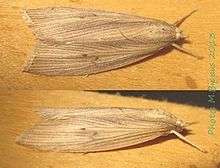Chilo sacchariphagus
| Chilo sacchariphagus | |
|---|---|
| Scientific classification | |
| Kingdom: | Animalia |
| Phylum: | Arthropoda |
| Class: | Insecta |
| Order: | Lepidoptera |
| Family: | Crambidae |
| Subfamily: | Crambinae |
| Genus: | Chilo |
| Species: | C. sacchariphagus |
| Binomial name | |
| Chilo sacchariphagus (Bojer, 1856) | |
| Synonyms | |
| |

Chilo sacchariphagus (spotted borer) is a moth of the Crambidae family. It is originally found in South and South-East Asia, where there are three subspecies:
- C.sacchariphagus sacchariphagus in Malaysia, Indonesia, Indian Ocean.
- C. sacchariphagus indicus in India.
- C.sacchariphagus stramineellus in the south of China, Taiwan.
The larvae are a major pest to sugar cane.
In 1850 Chilo sacchariphagus sacchariphagus had been introduced in sugar cane setts from Java to Mauritius,[1] around 1855 also to the neighbouring island Réunion. Its presence is also confirmed in Madagascar and Comores.[2] In 1999 the first presence on the African continent was confirmed in sugar estates in Mafambisse, Mozambique and in 2001 also in Marromeu.[3]
Biological control
In attempting its biological control, the Mauritian Government had introduced 31 species of parasitoids. Only two became established (Trichogramma australicum and Cotesia flavipes) [4]
References
| Wikimedia Commons has media related to Chilo sacchariphagus. |